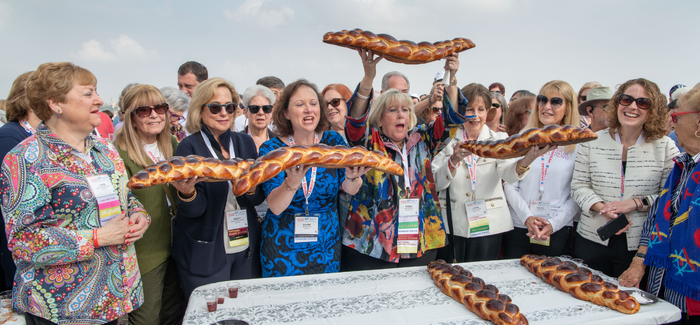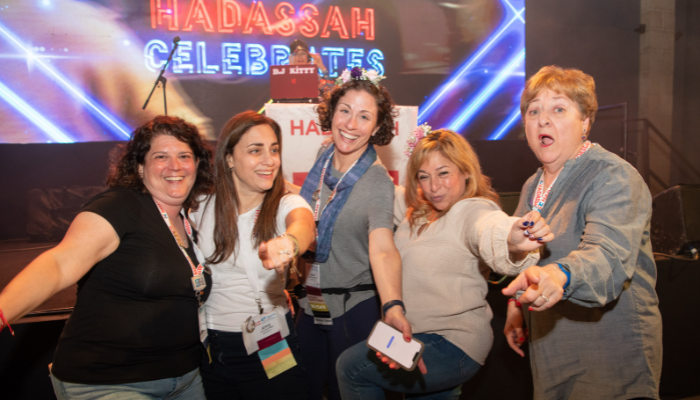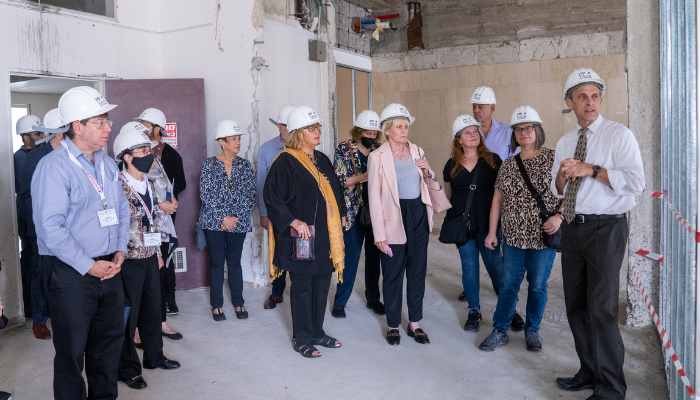Hadassah
Feature
Together in Israel for Hadassah’s 100th National Convention

Perhaps it was bashert that the taxi driver who drove me to the airport as I was leaving Israel following Hadassah’s 100th National Convention in Jerusalem in mid-November was a man who was only too familiar with Hadassah Hospital and what he termed its “avodat kodesh,” or holy work.
David Nissim’s stepdaughter, Adi Hooja, was critically injured during a deadly suicide bombing in the center of Jerusalem in December 2001. She was 11 years old at the time. A medical team at Hadassah not only saved her life but also her leg, which was filled with shrapnel.
More than 20 years and many operations later, including one as recently as November, Hooja is walking, leading a relatively normal life and continuing to receive treatment at the hospital. Her stepfather said his family is “more than grateful” for all that Hadassah and her doctors have done for her.
Indeed, the healing work of Hadassah, the Women’s Zionist Organization of America, and the Hadassah Medical Organization was on full display throughout the four official days of the convention—“Together in Israel: Our Pride. Our Purpose.”—as well as during the wide array of pre- and post-convention programming.

It was on display at the numerous gatherings where doctors, nurses and their patients recounted poignant and often miraculous journeys from illness and injury to treatment and recovery.
It was on display at the Jerusalem Theater during the convention’s opening Hadassah Pride program when Alexander “Sasha” Buzunar was surprised with a dramatic reunion with his mother. The 14-year-old teenager from the Russian-captured Ukrainian port city of Mariupol had found refuge from the war at Hadassah Neurim, a Hadassah-supported youth village, and hadn’t seen his mom, Alina, in eight months.
READ MORE: Celebrating Hadassah From Generation to Generation
It was on display at Hadassah Ein Kerem and Hadassah Mount Scopus, HMO’s two hospital campuses in Jerusalem that attendees visited to witness firsthand the innovative medical technology and pioneering work being done.
And it was on display among the more than 350 leaders, members, associates and staff from every corner of the United States who reveled—with dancing, singing and lots of schmoozing—in the opportunity to physically come together after nearly three years of a pandemic that had relegated most Hadassah activities to Zoom.

“This has been my dream since the day I accepted the presidency,” Rhoda Smolow, Hadassah’s national president, told the participants at the welcome dinner on November 14. “We needed to do this. We needed to be together. We needed for you to take that first step out the door, on the plane, on the tarmac and in Israel. This is what makes us Hadassah.”
What makes Hadassah is recognized by all kinds of Israelis. Hadassah Hospital “represents much more than a medical institution,” declared Nachman Shai, who was concluding his tenure as head of Israel’s Ministry of Diaspora Affairs when he spoke at the opening program.

“It is an establishment with the goal of healing a nation, one that has a close connection to all of our hearts,” Shai said. “It has remained a cornerstone of Jerusalem from before the establishment of the State of Israel until this day. I owe you all a personal thank you for this tremendous contribution.”
Tom Nides, the United States ambassador to Israel, whose mother was an active Hadassah leader in his hometown of Duluth, Minn., recounted his personal experience at Ein Kerem during the Hadassah Honors event that bestowed the Henrietta Szold Award upon past National President Marlene Post and the inaugural Power of Esther Award to Israel’s first lady, Michal Herzog.
When he felt sick just a day earlier, Nides told the crowd, he called Dalia Itzik, chair of the board of HMO. Before he knew it, he was at the emergency room of the hospital getting the royal treatment for what turned out to be just a cold.
What follows are some snippets and scenes from the convention.
Moving Hearts
Dr. Sagui Gavri, head of pediatric cardiology at Hadassah Ein Kerem, was in the cath lab treating a Palestinian child from East Jerusalem in May 2021 when the red alert on his phone went off, signaling incoming rockets from the Gaza Strip. Hours later, he got word that his home on Kibbutz Nir Am, which borders Gaza, was hit, destroying the roof and surrounding fields.
That didn’t stop his work then, or now, as his commitment to treating Palestinian children remains unwavering. More than 200 from the Gaza Strip have been treated over the past 15 years, he said.

He has a special relationship with one of those children, Fayez Hasheem, who almost died three times in his short lifetime, Dr. Gavri said, “and we pulled him out of death every time in the last minute.”
For Fayez, Dr. Gavri is like a father. “He treats me like I’m his son,” said the adolescent, who took the stage at the convention with his mother and sister.
His mother, Layali Hasheem, still gets emotional when she talks about their experiences at Hadassah. “When I’m in Hadassah, I feel like I’m in my home with my family,” she said.
Dr. Gavri said he is not naive, but he is hopeful that these interethnic interactions and relationships formed at Hadassah Hospital are “seeds that can make a change—maybe.”
Honoring Two Impactful Leaders
Marlene Post has been a powerful force in the Jewish world for decades, but nowhere has her impact—and her commitment—been greater than at Hadassah. The organization showed its appreciation for her half-century of service by honoring her with its highest honor, the Henrietta Szold Award, at the convention.
At a festive evening at the Waldorf Astoria Jerusalem that included musical performances as well as an act from world-renowned Israeli mentalist Lior Suchard and dancing in the aisles, some 500 people gathered to honor both Post and Michal Herzog, Israel’s first lady, who received Hadassah’s inaugural Power of Esther Award.

Herzog, an attorney, was recognized as “a role model for women in Israel and abroad, an advocate for those in need and a champion of social mobility,” as denoted on the award itself.
“Soft power is perhaps the central tool available to first ladies,” she said. “For me, it has become the best instrument for promoting the causes dear to my heart, such as awareness for mental health; social mobility and equality; psychological humanitarian support.”

She also congratulated Post, as did her husband in his video remarks a day earlier when he welcomed the convention participants and noted that so many of Hadassah’s contributions “are a seamless part of this country and its story.”
Noting his admiration for Szold, Hadassah’s founder, and the organization’s motto, “The Power of Women Who Do,” the president lauded the past national president and current chair of Hadassah Magazine. Post is “by definition a woman who did and does, and will do,” he said.
Ellen Hershkin, a past national president, presented the award to Post, who was honored “for her extraordinary service, lasting contributions to the ideals of Zionism, Israel and the Jewish people worldwide.” She “empowers emerging generations of leaders,” the award continues, and “embodies the spirit of innovation, global perspective and courage to create a more just and equitable world.”
Among the many achievements under her presidency from 1995 to 1999, Post, a former nurse and nurse educator, opened the first Hadassah office in Washington, D.C., and launched the Hadassah Foundation, which funds programs to benefit women and girls in Israel and the United States.
In her acceptance speech, Post noted her beginnings in the Catskills town of Monticello, N.Y., where she was born 85 years ago, and credited Hadassah, which “made me who I am in many, many, many ways.”

In addition to her involvement in Hadassah, Post has held many lay positions elsewhere in the Jewish world, including founding chair of the Birthright Israel program and founding chair for the American Friends of the Israel Sport Center for the Disabled. She continues to hold leadership positions with numerous organizations, among them the Jewish Agency for Israel and the Jewish National Fund.
In the Field

Convention participants spread out across Jerusalem and the country for all kinds of excursions, from culinary tours of Mahane Yehuda to a military briefing along part of Israel’s security barrier. And of course, to Hadassah Hospital’s two campuses and to Meir Shfeyah, one of two Youth Aliyah villages supported by Hadassah.

At Hadassah Ein Kerem, major donors to the Round Building were honored at a ceremony beneath the Chagall Windows of the Abell synagogue. Delegates had the opportunity to don hard hats and tour the construction site. Once the renovation is complete, it will house several key hospital departments as well as updated operating rooms, and it will increase by 200 the number of patient beds available.


Dr. Yoram Weiss, HMO’s director general, noted among its many recent accomplishments that Hadassah was in the forefront of Covid treatment and was the first Israeli hospital to send medical teams to the Polish border with Ukraine to assist those fleeing the war, treating 35,000 patients.

At Meir Shfeyah Youth Aliyah Village, associate and longtime Hadassah supporter Burt Krull met with a teacher and her students in a learning center made possible by his donation, at the request of his late wife, Alma, in honor of three Hadassah legends: Barbara Sofer, Audrey Shimron and Barbara“BG” Goldstein. Shimron, who has stepped down from her longtime position as executive director of HWZOA’s Israel Offices, was honored at a special ceremony during the convention. Shimron now holds the title of executive director emeritus. Suzanne Patt Benvenisti is the new executive director.
For more coverage, including videos and a photo gallery, click here.
Lisa Hostein is the executive editor of Hadassah Magazine.










 Facebook
Facebook Instagram
Instagram Twitter
Twitter
Leave a Reply